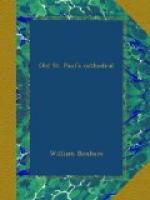To his shrine also an annual pilgrimage was made, and Lord Mayor Barkham, on renewing the above inscription A.D. 1622, puts in a word for himself:
“This being by Barkham’s thankful
mind renewed,
Call it the monument of gratitude.”
We pass on to the time of the “second church,” the Old St. Paul’s which is the subject of this monograph.
The importance of London had been growing without interruption ever since its restoration by King Alfred, and it had risen to its position as the capital city. This largely showed itself when Archbishop Lanfranc, in 1075, held a great council in St. Paul’s, “the first full Ecclesiastical Parliament of England,” Dean Milman calls it. Up to that time, secular and Church matters had been settled in the same assembly, but this meeting, held with the King’s sanction, and simultaneously with the Witan, or Parliament, established distinct courts for the trial of ecclesiastical causes. It decreed that no bishop or archdeacon should sit in the shiremote or hundred-mote, and that no layman should try causes pertaining to the cure of souls. The same council removed some episcopal sees from villages to towns, Selsey to Chichester, Elmham first to Thetford, then to Norwich, Sherburn to Old Sarum, Dorchester-on-Thame to Lincoln.
Another council of the great men met in St. Paul’s in the course of the dispute between Henry I. and Anselm about the investitures, but it ended in a deadlock, and a fresh appeal to the Pope.
In the fierce struggle between Henry II. and Archbishop Becket, Gilbert Foliot, Bishop of London, while apparently quite honest in his desire to uphold the rights of the Church, also remained in favour with the King, and hoped to bring about peace. Becket regarded Foliot as his bitter enemy, and, whilst the latter was engaged in the most solemn service in St. Paul’s (on St. Paul’s Day, 1167), an emissary from the Archbishop, who was then in self-imposed exile abroad, came up to the altar, thrust a sentence of excommunication into his hands, and exclaimed aloud, “Know all men that Gilbert, Bishop of London, is excommunicated by Thomas, Archbishop of Canterbury.” When Becket returned to England, December 1st, 1170, after a hollow reconciliation with the King, he was asked to remove his sentence of excommunication on Foliot and the Bishops of Salisbury and York, who had, as he held, usurped his authority. He refused, unless they made acknowledgment of their errors. The sequel we know. The King’s hasty exclamation on hearing of this brought about the Archbishop’s murder on the 29th of the same month. During the excommunication, Foliot seems to have behaved wisely and well. He refused to accept it as valid, but stayed away from the cathedral to avoid giving offence to sensitive consciences. After Becket’s murder, he declared his innocence of any share in it, and the Bishop of Nevers removed the sentence of excommunication.




